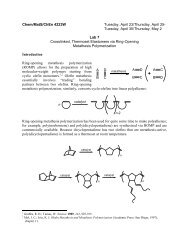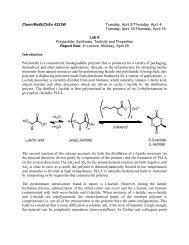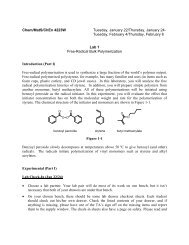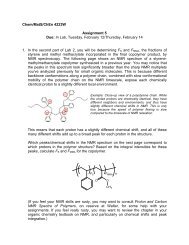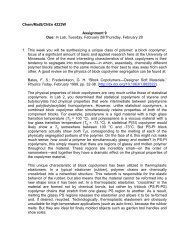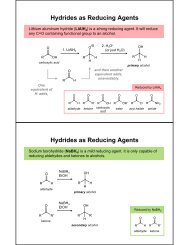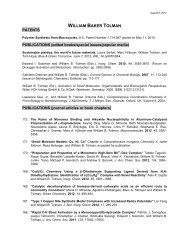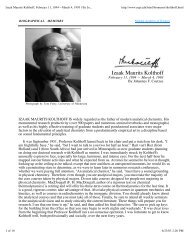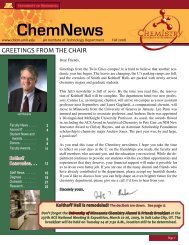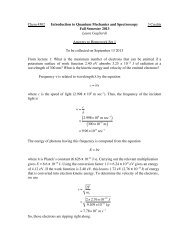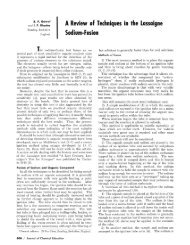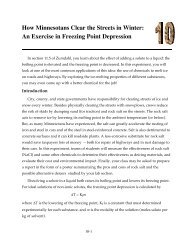Inverse Opal Photonic Crystals - Department of Chemistry ...
Inverse Opal Photonic Crystals - Department of Chemistry ...
Inverse Opal Photonic Crystals - Department of Chemistry ...
Create successful ePaper yourself
Turn your PDF publications into a flip-book with our unique Google optimized e-Paper software.
teams <strong>of</strong> students. The size <strong>of</strong> the polymer spheres directly affects the pore size <strong>of</strong> the inverse<br />
opals, which in turn affects the color <strong>of</strong> light reflected by the inverse opals. It is recommended<br />
that each group prepares a different size batch <strong>of</strong> spheres (if multiple batches are prepared) or the<br />
instructor prepares different sizes <strong>of</strong> PMMA spheres prior to the lab period. This will allow for<br />
comparisons <strong>of</strong> the optical properties <strong>of</strong> the products to be made.<br />
The entire process - from the synthesis <strong>of</strong> a colloidal suspension <strong>of</strong> PMMA through the<br />
attainment <strong>of</strong> ready-to-use PMMA template spheres - takes roughly one week (Figure 10). We<br />
recommend assembly <strong>of</strong> the complex components <strong>of</strong> the polymer apparatus by the instructor<br />
prior to the laboratory period (detailed in Figure 8 and the discussion above). The emulsion<br />
polymerization procedure requires the heating <strong>of</strong> a large quantity <strong>of</strong> water and methyl<br />
methacrylate (MMA) to 70 or 80 °C, which may require up to two hours. The instructor may<br />
choose to begin heating the mixture before the lab period begins to save time. Follow-up<br />
centrifuging and water decanting is also required. It is left up to the instructor’s discretion<br />
whether to handle these follow-up procedures, or to designate students to carryout these steps.<br />
Table 1 provides a good guideline to follow in the preparation <strong>of</strong> PMMA spheres. Templating<br />
with these three sphere sizes will produce inverse opals with distinctly different reflected colors.<br />
The parameters may be adjusted to produce PMMA spheres <strong>of</strong> intermediate sizes. To make<br />
larger spheres, use more MMA (while keeping the amount <strong>of</strong> water constant), use a lower<br />
temperature, or use less initiator. To make smaller spheres, use less MMA, use a higher<br />
temperature, or use more initiator. We recommend following the recipes in Table 1 as these<br />
PMMA sizes will produce inverse opals with light reflections in the visible region. Spheres <strong>of</strong><br />
smaller or larger sizes will lead to products without visible reflections.<br />
Using the parameters in Table 1 will lead to inverse opal silica materials that appear blue-violet,<br />
green, and orange-pink in reflected light for the small, medium, and large PMMA-templated<br />
products, respectively. Each preparation will yield in excess <strong>of</strong> 250 grams <strong>of</strong> PMMA.<br />
Quantities may be scaled-down as appropriate to fit the class size. Use care in the handling <strong>of</strong> all<br />
chemicals and observe safe lab practices. Wear goggles, gloves, and a lab coat during this<br />
experiment. Perform all experiments in a ventilated hood.<br />
18



